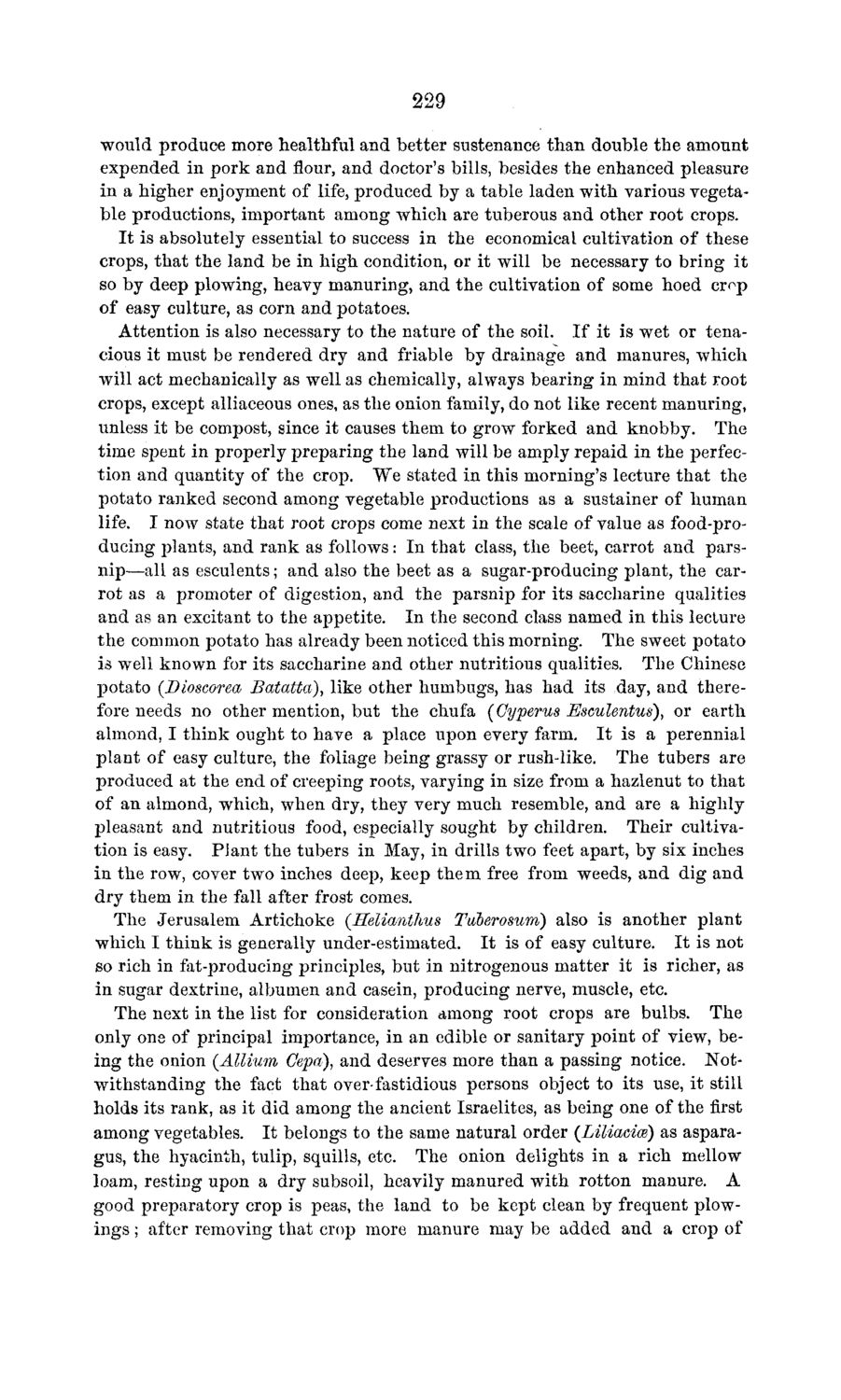| |
| |
Caption: Board of Trustees Minutes - 1869
This is a reduced-resolution page image for fast online browsing.

EXTRACTED TEXT FROM PAGE:
229 would produce more healthful and better sustenance than double the amount expended in pork and flour, and doctor's bills, besides the enhanced pleasure in a higher enjoyment of life, produced by a table laden with various vegetable productions, important among which are tuberous and other root crops. I t is absolutely essential to success in the economical cultivation of these crops, that the land be in high condition, or it will be necessary to bring i t so by deep plowing, heavy manuring, and the cultivation of some hoed crop of easy culture, as corn and potatoes. Attention is also necessary to the nature of the soil. If it is wet or tenacious it must be rendered dry and friable by drainage and manures, which will act mechanically as well as chemically, always bearing in mind that root crops, except alliaceous ones, as the onion family, do not like recent manuring, unless it be compost, since it causes them to grow forked and knobby. The time spent in properly preparing the land will be amply repaid in the perfection and quantity of the crop. We stated in this morning's lecture that the potato ranked second among vegetable productions as a sustainer of human life. I now state that root crops come next in the scale of value as food-producing plants, and r a n k as follows: In that class, the beet, carrot and parsnip—all as esculents; and also the beet as a sugar-producing plant, the carrot as a promoter of digestion, and the parsnip for its saccharine qualities and as an excitant to the appetite. In the second class named in this lecture t h e common potato has already been noticed this morning. The sweet potato is well known for its saccharine and other nutritious qualities. The Chinese potato (Dioscorea Batatta), like other humbugs, has h a d its day, and therefore needs no other mention, but t h e chufa (Cyperus Esculentus), or earth almond, I t h i n k ought to have a place upon every farm. I t is a perennial plant of easy culture, the foliage being grassy or rush-like. The tubers are produced at the end of creeping roots, varying in size from a hazlenut to t h a t of an almond, which, when dry, they very much resemble, and are a highly pleasant and nutritious food, especially sought by children. Their cultivation is easy. P l a n t the tubers in May, in drills two feet apart, by six inches in the row, cover two inches deep, keep t h e m free from weeds, and dig and dry them in the fall after frost comes. The Jerusalem Artichoke (Helianthus Tuberosum) also is another plant which I t h i n k is generally under-estimated. It is of easy culture. I t is not so rich in fat-producing principles, but in nitrogenous matter it is richer, as in sugar dextrine, albumen and casein, producing nerve, muscle, etc. The next in the list for consideration among root crops are bulbs. The only one of principal importance, in an edible or sanitary point of view, being the onion (Allium Gepa), and deserves more than a passing notice. Notwithstanding the fact t h a t over-fastidious persons object to its use, it still holds its rank, as it did among the ancient Israelites, as being one of the first among vegetables. I t belongs to the same natural order (Liliacice) as asparagus, the hyacinth, tulip, squills, etc. The onion delights in a rich mellow loam, resting upon a dry subsoil, heavily manured with rotton manure. A good preparatory crop is peas, the land to be k e p t clean by frequent plowi n g s ; after removing that crop more manure may be added and a crop of
| |